Workation » Best Workation Locations and Why You Should Visit Them » Italy Workation – Working and Vacationing in Italy » Regions of Italy and Where to Visit » Central Italy Region and Where to Visit
Central Italy Region and Where to Visit
When thinking of what you love about Italy or might find intriguing about the country known for its passion and cuisine, history and culture, it is easy to look no farther than Central Italy’s regions of Lazio, Le Marche, Tuscany, and Umbria. Home to many of the best places to visit in Italy, the terrain is famous for the lush hills and serene coastline but also consists of the rugged peaks of the Apennines Mountains. The snowmelt and rainfall along the high-altitudes feeds the lowland plains and valleys sweeping through the central hills flush with thriving vineyards and olive orchards.
The waters in the east run to the Adriatic coast, while in the west, the rivers lead to the Tyrrhenian Sea. The central regions of Lazio and Tuscany have grown their tourist trade exponentially over the centuries due to their proximity to Rome and Florence. Visitors have expanded their horizons in search of the small hilltop towns known for their quiet streets and cypress trees, secluded villas and rustic cuisine. Etruscan artifacts lay beneath the Roman ruins around the hills of Umbria, Tuscany, and Lazio.
Le Marche remains a hidden jewel around Central Italy, segregated from the vibrant rolling terrain of Umbria and Tuscany by the intense, abrasive hills making it difficult to travel between towns by any direct route, which only enhances the charms of the secluded, unspoiled heritage. The total area of Central Italy consists of more than 22,400 square miles and encompasses Rome, the national capital and most densely populated city in the country.
Charming ski resorts attract wealthy Italians and Europeans eager to step away from the crowds in the Alps and the Dolomites. Beachside getaways provide unforgettable views to the turquoise Adriatic and indigo Tyrrhenian Sea. Protected lakes, marshes, foothills, and medieval towns provided unforgettable trekking opportunities accentuating the extravagant castles and artwork that changed the course of Western Europe’s creative aesthetic. No matter what you like to do or where you want to go, you can find the right Italy Workation package for you.
Tuscany
Although Rome may be a city, and former empire, synonymous with Italy, Tuscany is the region most people think of when conjuring the perfect trip or imagining a delightfully simple, relaxed life far away from their home. The region contains idyllic hill towns with medieval towers, flowing landscapes draped in green hills, radiant fields of sunflowers, and a reputation for warring city-states that shaped the art, architecture, and urban design of the Middle Ages until the Renaissance.
The gorgeous coastline touches the Ligurian and Tyrrhenian seas amongst the nearly 8,900 square miles of landscape. Hills account for more than 5,900 square miles, encompassing nearly two-thirds of the region. The Arno River Valley only contains 750 square miles of land, mainly around the banks of the Tuscan capital of Florence. The regions of Lazio and Umbria border Tuscany to the south, with Le Marche accounting for a sliver of the border to the east. Emilia-Romagna accounts from the majority of the Tuscan boundary along the east and north, while a small extension of Liguria touches Tuscany to the west above the coastline.
The mountain chains and temperate sea air protect the coast from harsh cold. The rugged foothills bordering the inland hills and valleys cause harder rain in the spring and cold fronts in the winter, actively freezing and thawing the soil. The seasonal cycle made the region ideal for harvesting grains during the reign of ancient Rome.

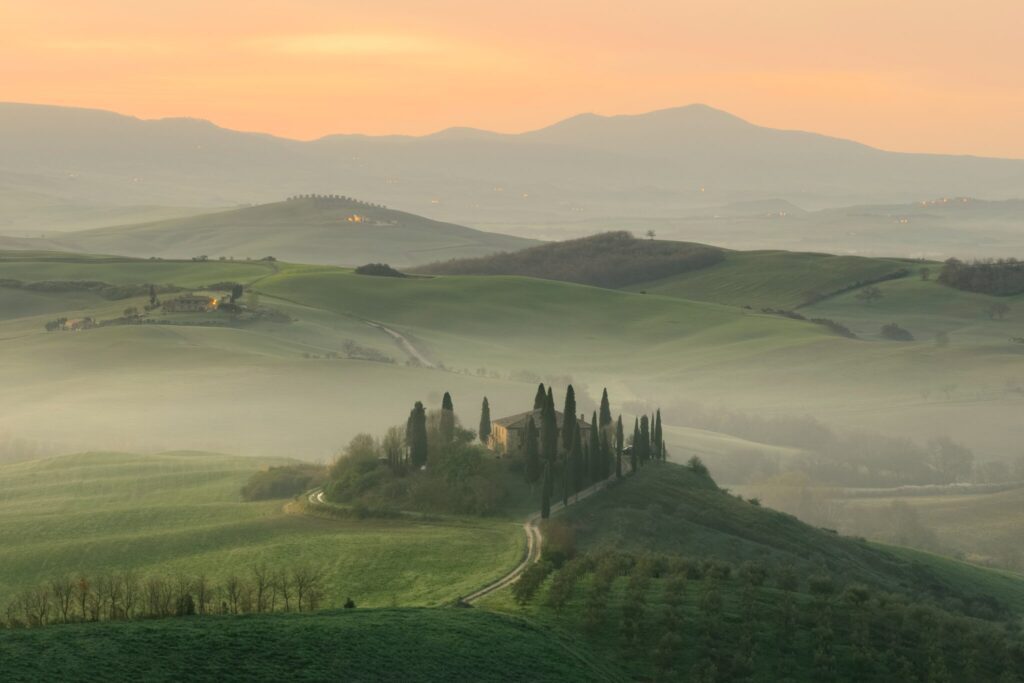
The history of Tuscany dates back to before the Roman republic with artifacts discovered correlating to the late Bronze and Iron Ages to parallel early Greek civilizations. Early Tuscans stemmed from the Apennine culture between 1350 and 11150 BC, a culture known for trading with Minoan and Mycenaean civilizations from the Aegean Sea. The Etruscans created the first major civilization by implementing agriculture, mining, and a transport infrastructure around the Arno and Tiber River from the 8th to the 6th century BC before succumbing to the Romans.
The marvels of the ancient, medieval, and Renaissance history compare only to the majesty of the natural history in the region spreading across such spectacles as the Apuan Alps, Orbetello Lagoon, and the Gulf of Baratti. Thermal baths, pink egrets, and rocky coastal cliffs add to the unique character drawing more than just art and cultural enthusiasts to the countryside and shoreline. Adventurers sail, windsurf, canoe, scuba dive, hike, mountain bike, horseback ride, or cycle between hillside towns. While other regions or cities around the world fail to live up to their reputations of romance, political intrigue, and enchanting culture, Tuscany surpasses any and every anticipation, revealing some of Italy’s best-loved cities and surprising gems, along with cradling the beginnings of the Italian Renaissance, one of Europe’s greatest philosophical and artistic revolutions.
Florence
The heart of Tuscany lies in Florence, it’s capital and center both literally and existentially. The city borders the Arno River centrally located between Rome and Milan with a history packed with action. Bridges connect the neighborhoods across the water punctuated by the massive dome of the cathedral designed by Filippo Brunelleschi.
Find a number of the best experiences in Italy around Florence as you find a city Romans originally designed, giving way to a period of flourishing trade and a thriving banking trade during the medieval era. Julius Caesar established the settlement in 59 BC for veteran soldiers, using his experience as a commander to create a city in the style of an army camp connected by main streets intersecting at a public plaza. Florence grew to become one of the most important cultural and economic centers of Europe during the 14th to 16th centuries, inspiring artists, such as Michelangelo, philosophers like Machiavelli, and poets such as Dante Alighieri, the latter of whom solidified the Tuscan dialect as the official language of Italy with his authoring the renowned epic La Comedia Divina, The Divine Comedy, consisting of Inferno, Purgatory, and Paradise.
The most famous family of Florentine descent emerged from behind the scenes of power in the 15th century under the guidance of Cosimo de’ Medici, who laid the groundwork of lending money to the pope, thereby influencing the city’s democracy in their favor. The romantic, enchanting, and irresistible ambiance of the city emanates from the world-class art and the connection to the rustic cuisine of the regional heritage. The pedestrian-friendly city overwhelms newcomers with its grandeur in the form of preserved sculptures and paintings, along with maintained architecture as sumptuous as the works of art. Cathedrals, artisan shops, boutiques, and fanciful fountains embody the sweet style once evoked by Dante and his compatriot of the city Guido Cavalcanti.
The destination poses a conundrum for visitors on a budget. The concentrated historic city center provides a grand destination to wander and explore on foot but leaves little room for budget accommodations. Museums, churches, and basilicas add to great expense if trying to visit all the various sites large and small, along with the shops, cafes, and restaurants.
Siena
Art, architecture, cuisine, and Tuscan spirit isn’t limited to Florence; in fact, city-states rivaled Florence with patrons eager to support the arts and armies matching the power and strength of the regional capital for centuries before eventually falling beneath the banner of the famous city. Siena is one of the cities whose architecture soars amidst the elaborate open-air museum decorating the cobbled lanes and atmospheric streets. The historic city center is pedestrian friendly, allowing locals and visitors to stroll between medieval walls and gothic décor connecting the various districts.
The neighborhoods retain their colorful nature dedicated to winning the city-wide horse race known as the Palio, which takes place twice a year in the summer. Artisanal boutique shops, pastry shops emitting sweet aromas, and restaurants providing succulent scents line the vivacious street. The city began to prosper in the 12th century and reached an artistic zenith rivaling the masters of Florence between the 13th and 14th centuries. The cathedral and palaces retain immaculate brickwork made from red clay, standing as monuments to Gothic architectural design.
Legend tells that Senio, the son of Remus, founded the city, which accounts for the numerous statues of baby twins, representing Romulus and Remus, suckling the she-wolf. Beyond the local folklore, historians have discovered artifacts and settlements consistent with the Etruscans followed by the Romans. Banking and a popular wool trade brought prestige to the city, leading the local leaders to write a constitution as early as 1179. The main public square, known as Piazza del Campo, has a unique shell shape and features sidewalk cafes, a resident fountain, and the dramatic Palazzo del Pubblico standing beneath the fascinating attached bell tower of Torre del Mangia standing at over 330 feet tall. Enjoy more of Siena and Italy by learning what to do before taking your Italy Workation
Towns of Tuscany
As a whole, the region of Tuscany is home to unforgettable hilltop villages and seas of roaming vineyards. Travelers have enjoyed a long pastime of getting lost along the small roads to discover hidden gems and fabulous folklore, ancient streets and rustic cuisine different from anywhere else in the world.
Even cities in Tuscany, such as Florence and Siena, retain a small-town ambiance within their historic city centers. The following list contains a selection of towns that have distinguished themselves through the conservation of landscape, cultural heritage, and cuisine to form a welcoming atmosphere within the distinctive provinces of the greater region.
Slanting red-tiled roofs, ancient Etruscan settlements draping over the lush grasses and spreading to the foothills of the Apennines, along with stone mazes and marble alleyways will tear your mind away from stereotypical destinations of Florence and Siena, or the tilting figure of Pisa’s Leaning Tower.

Lucca
The town of Lucca clings to the lush lowlands of the Serchio River basin between the marble frontispieces of Pisa to the south and the coastline of the Tyrrhenian Sea to the northwest. The preserved Renaissance walls continue to surround the city, drawing new hoards to the historic center instead of rappelling them.
Cypress and eucalyptus trees decorate walkways and upper ramparts turning the former bulwarks into a pleasant, walkable park. Etruscans founded the city until Romans overtook the settlement in 180 BC. The rectangular grid of the city center preserves the Roman street plan centered on Piazza San Michele, the site of the ancient Roman forum. Julius Caesar, Pompey, and Crassus reaffirmed their political alliance in 56 BC, creating the First Triumvirate.
The town grew in prominence after asserting itself as an intendant commune in the 12th century. For nearly 500 years Lucca remained independent, giving refuge to the likes of Dante Alighieri, and homes to Giacomo Puccini and Pope Lucius III. The city-state eventually fell to Napoleonic forces, with the emperor installing Elisa Bonaparte Baciocchi, his sister, as the Princess of Lucca until 1847.
Under the reign of Elisa Bonaparte, antique walls turned into contemporary gardens consisting of a two and a half-mile path of panoramic views and quiet corners. Locals often refer to Lucca passionately as the “City of one hundred and one churches,” due to the large number of religious buildings representing marvelous examples of Italian architectural styles through the centuries.
Volterra
Saying a town is Tuscany is charming is like calling a puppy cute; the nature of the word is implied and Volterra is no exception. With so many distinctive towns in Tuscany, it is hard to choose which to see and which to save for another exploration through one of Italy’s most popular regions. Volterra is located in the province of Pisa, 50 miles away from the regional capital of Florence. The Etruscans fabricated Velathri on the hillside of what would become Volterra, one of the 12 main settlements of the Etruscan Confederation dating back to the 4th century BC.
A series of walls nearly 24,000 feet long protected the prestigious ancient urban center and the fountains cultivating the fields and pastures. The settlement allied with Rome in the 3rd century BC and became the residence of a bishop by the 5th century AD. The depth of history accentuates the ambiance of culture and heritage, of which locals are proud to convey, connecting the wealth of ancient wonders to a history of rebellion against the Florentine Republic. The medieval ramparts provide splendid views to the windswept town forever associated with the popular Twilight series after author Stephanie Meyer decided the cobbled streets and feudal architecture were an ideal setting for the world’s vampire coven.
The streets and architecture follow the original Etruscan design giving way to elements of Roman settlement. The historic center promotes a timeless atmosphere with shops selling Tuscan delicacies and intricate handcrafts, many of which are shaped by hand from alabaster.
The town stands less than 12 miles away from the popular destination of San Gimignano, a former city-state known for its stunning towers. Teeming tourists surge through the streets in the shadow of the towers, while Votlerra retains a sense of serenity amidst the two Etruscan temples, Roman water basin, and archeological park located beside the Etruscan gate, highlighting the town’s rustic vitality and captivating complexity.
For a unique perspective on local history and the evolution of community, visit Via Matteotti, #12. A line of doorbells decorates the typical walls of the historic palace. The former regal residence was refurbished after the 18th century rise of the middle class, conforming to the social revolution. Instead of a single home, the grounds became single-family homes retrofitted for the middle class. Members of the original owning family continue to live in one of the apartments.
All roads and lanes in the city lead back to the main square of Piazza dei Priori, bordered by the magnificent 13th century Priori Palace. The three-story facade contains double arched windows and glazed terracotta coats of arms connected to Florentine magistrates. In 1472 the two Marzocco lions, the symbol of Florence, decorated the walls to indicate the seat of the Captain of Justice. The 13th-century walls surrounding the city were built when the Ghibellines succeeded the Guelfs, constructing a smaller circuit easier to defend than the former Etruscan walls. Six different gates stand along the walls allowing people to enter and exit the urban center.
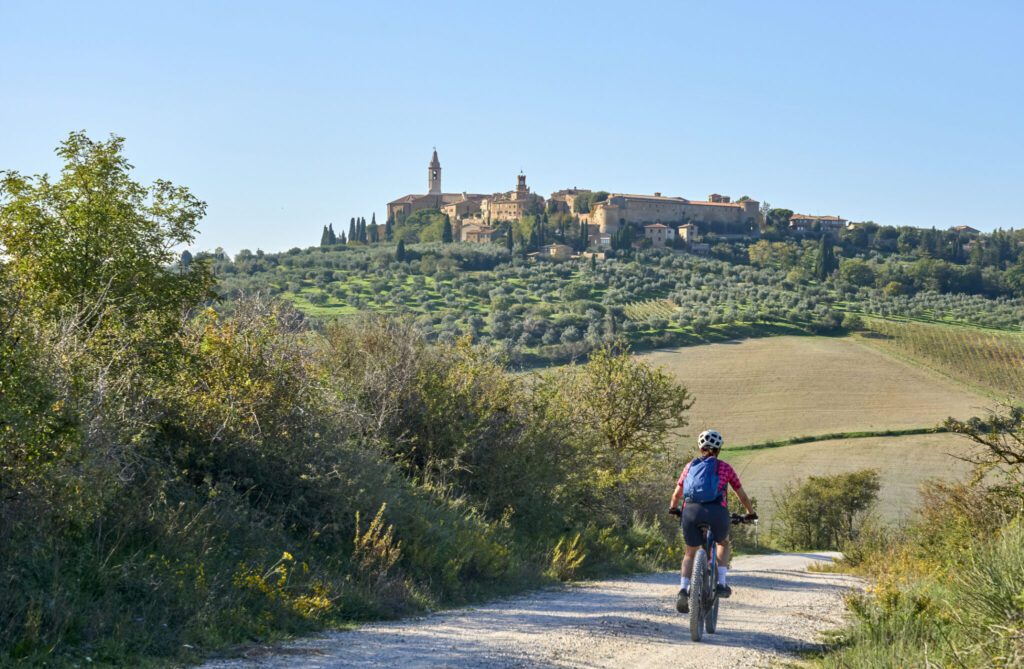
Pienza
The little town of Pienza has a big impact on visitors as a town filled with light and built upon the Renaissance principles of proportional balance. The village began as Corsignano and was first mentioned in the 9th century. The Piccolomini family emerged as the powerful nobility in the 14th century amidst settling Franciscans. Aeneas Silvius Piccolomini, a Renaissance humanist born of an exiled Sienese family, became Pope Pius II in September of 1458, ordering the entire village rebuilt as an ode to the enlightenment, along with renaming the town after himself.
The urban planning concepts created an impetus adopted by other towns and cities across Italy and eventually spanning the European continent. Architect Bernardo Gambarelli from Florence worked with famous humanist and architect Leon Battista Alberti to construct a community embodying Renaissance standards and ideals. Pope Pius II consecrated the cathedral in August of 1462 during a summer retreat. The town is located in the province of Val d’Orcia, atop a hill surrounded by verdant vineyards and the lush, fertile fields.
The main public square of Piazza Pio II contains a harmonious shape emitting a sense of dignity and gravity to the bordering architecture crafted from travertine stone. The Duomo hosts a selection of lavish period frescoes and the octagonal bell tower stands above the ancient crypt. The Pecorino of Pienza is one of the tastiest sheep’s cheeses renowned for its delicate flavor based on the aging process.
Shops and stalls around town offer samples of the stunning cheese, along with information on the best ways to enjoy the ingredient, whether on its own or as a garnish to enhance typical Tuscan cuisine. The town is one of the celenbrated Unesco World Heritage Sites In Italy to v isit on Workation and since 1996 has dedicated itself to preserving the character of the ideal Renaissance town, in spirit and aesthetic.
Umbria
The central heart of Italy shines with greenery, fine cuisine, a depth of heritage, and remains just off the beaten path between the more notable regions of Tuscany and Lazio. The region has served as a popular destination for pilgrims eager to visit the birthplace of St. Francis or active travelers happy to cycle or trek through the rolling hills more commonly associated with the Tuscany countryside. Tourists who find Tuscany or Lazio too crowded discover a new favorite destination in the bountiful beauty of Umbria’s fertile landscape decorated with mountains, woods, hills, and vineyards. Local cuisine highlights the flavors of wild boar and prized truffles.
The rolling terrain casts shadows over the river valleys populated by chestnut groves and elm forests. The landlocked region has inspiring Medieval charm populated with mysteries, mysticism, and captivating folklore. Italy’s largest body of water, Lake Trasimeno, decorates the sprawling plain encompassing nearly 50 square miles.
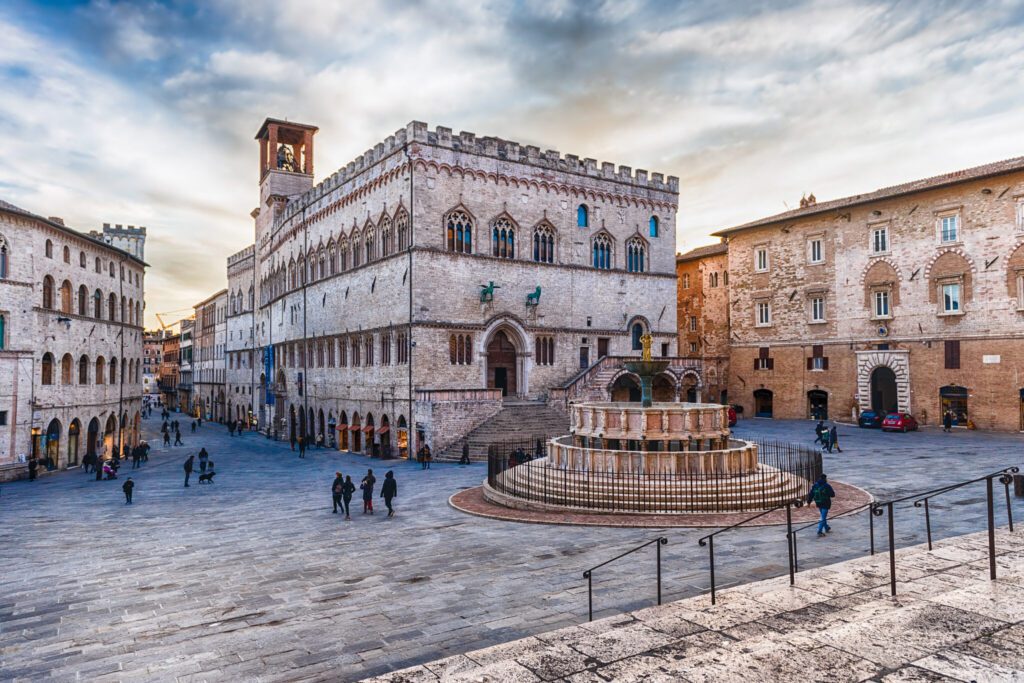
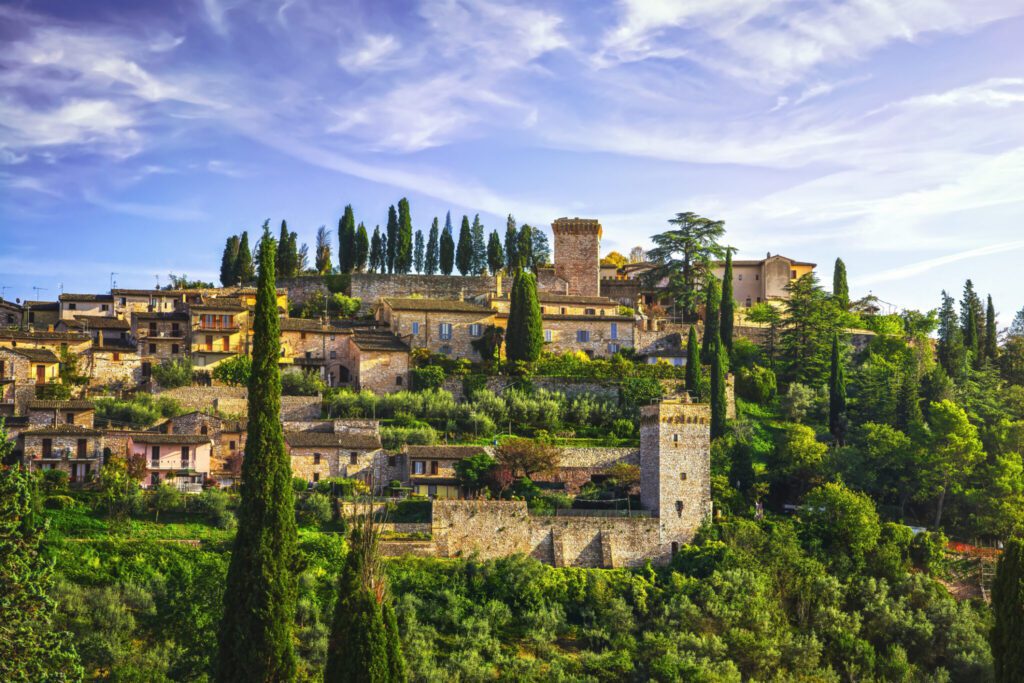
Etruscan settlements continue to populate the noble landscape beneath many medieval towns. Romance abounds around the stillness of Castiglione Lake and the waters of the Nera River feed the staggering 540-foot drop providing a perfect rush for canoers and kayakers. Monte Vettore, the highest point in the region, acts as a natural border between Le Marche to the east and Umbria in the west, reaching an elevation of more than 8,120 feet above sea level.
Popular destinations in the northern territory of the region are the capital of Perugia and Città di Castello, Gubbio and Montone. The central provinces host the pilgrimage destination of Assisi and the popular wines of Montefalco. The southern provinces contain the gorgeous towns of Orvieto and Todi. Etruscans, Romans, and feuding medieval families have all left their indelible marks on the serene hilltop towns adorned with Gothic majesty, cherished cuisine, and a heritage of welcoming customs.
Perugia
The capital of Umbria is a glutton for antique charm and unique cuisine, art and art lovers. The remains of the Etruscan walls showcase the power of one of the former settings of the 12 cities of the Etruscan Federation before falling under the rule of the Roman empire. Plaques and statues showcase the griffin, the symbol of the city embodying antique mystique and power. The substantial ancient town retains a youthful ambiance deriving from the two universities situated inside the former Etruscan city gates.
Università degli Studi was founded in the early 14th century and the University for Foreigners hosts one of the largest populations of foreign students in the country. Two perimeter walls surround the old city center reaching nearly two miles in length. A collection of city gates continues to allow locals and visitors entrance into the historic urban center, along with a series of Etruscan walls containing seven different portals. The historic city center is a certified 14th century village, known locally as a borgo. The Gothic basilica of San Domenico decorates the edge of Piazza Giordano Bruno and Via del Castellano and hosts the National Archeological Museum of Umbria.
The city has seen kingdoms, such as the French and Austro-Hungarians, seize control of the city, blending aspects of the culture into the city-state. This has led to Perugia’s fascinating connection to chocolate and the renowned annual jazz festival. Cobbled alleyways, arched staircase, and palaces framing marvelous piazzas steep the city in historic wonder juxtaposing the 21st century terrace cafes, restaurants, and bars. The town center located on a hilltop connected by a series of escalators and stairways is a great place to sit back and enjoy the Italian Coffee Culture. The medieval lanes and artistic buildings lead to Corso Vannucci.
The 15th and 16th century art school inspired the works of Perugino and Pinturicchio, along with a young Raphael who worked in Perugino’s studio until 1504. Perugia is one of the many towns across Italy in which a person would be content to walk around the streets and enjoy interacting with the fascinating facades and daily life inside the historic grounds. However, once in the city, here is a small list of sites you shouldn’t miss if you want to step away from the lively piazzas and tranquil stairways.
Assisi
Across Umbria’s great plain from the capital of Perugia stands the historic rival of Assisi, one of the main attractions of the region due to the rich religious heritage. The town climbs up the mixture of green and rugged slopes of Monte Subasio, which reaches a height above 4,200 feet above sea level. The first settlement dates back to 1,000 BC with a wave of immigrants moving northward from the Tiber Valley and inland from the Adriatic Sea. The migrants lived in small, fortified settlements on high ground until the Etruscans overpowered the area. Romans took control of Umbria after the Battle of Sentinum in the late 3rd century BC.
The commune thrived in the Middle Ages as an independent community connected to the Ghibellines in the 11th century. The constant struggle against the Guelphs of Perugia led to the kidnapping of Francesco di Bernardone. The soldier soon lost his taste for battle and prestige, renouncing the world to establish the Order of Friars Minor, solidifying his name in history as Saint Francis of Assisi, sharing the honor with Saint Catherine of Siena as a patron saint of Italy. Assisi has since spread outside of the original walls to encompass the foothills and slopes above the sprawling valley floor.
Devoted pilgrims and secular fans enthusiastic in following the traditions of the saint’s love for nature travel to the town of 3,000 inhabitants, accounting for between 4 to 5 million people annually. The main street harbors touristy concoctions, such as ceramics, medieval weapons, and religious sculptures, a single block can make a difference in your experience by introducing you to the more serene elements of the saint’s city where delicatessens serve Umbrian classic cuisine, such as guanciale, copa, or chocolate.
The Tau cross is the emblem of Saint Francis and the order, with local shops touting necklaces of gold or silver representing the crucifix of antiquity. The best time to experience the city is at dusk, when the sun spreads a mixture of pink, purple, orange, and gold across the white façade of the basilica. Day trippers return to their city of choice and the small town returns to an enchanting silence around the medieval city center, emphasizing Assisi as a place of peace.
Orvieto
In a region of charming hill towns, Orvieto stands out as one of the best due to its easy access to Rome, superb defensive position at the top of a rocky outcrop, and a history dating back to the Etruscans. The destination is popular as a day trip for tourists staying in Rome, Assisi, or Perugia. The town’s manageable size allows access to the major sights in a short amount of time and works as a fabulous base to stay for longer trips, highlighting the peaceful medieval lanes and grand countryside views of the evening without the small crowds. Elements of the ancient Etruscan city decorate the archeological museum Museo Claudio Faina e Museo Civico, which houses artifacts uncovered in the immediate neighborhoods of Orvieto.
An inscription on a tomb in the Cannicella necropolis states, “I am of Avile Katacina,” showcasing the person’s Etruscan-Latin first name and Celtic last name. The combination provides a modicum of insight into the complexity of ethnic survival in ancient Italy through peaceful relations. Rome annexed the settlement in the 3rd century BC due to its impregnability atop the high volcanic rock. A military governor controlled the city in the Middle Ages before falling under the domain of the Papacy until the 1860s with Italy’s reunification. The Cypress trees pepper the Umbrian plain below the prominent outcropping.
Old Town crowns the hilltop and the newer town stands near the base of the volcanic rock, housing the train station and cars gliding through the streets. The older, antique lanes are pedestrian friendly and give way to medieval piazzas and churches glowing with a cinematic beauty. Vineyards spread across the plains and the double spiral of St. Peter’s well draws visitors eager to see the 175-foot deep and 45-foot wide watering hole pitched in the 16th century after the Sack of Rome. The width and winding ramps allowed enough space for donkeys to haul the water from below.
The temperature changes dramatically the lower you travel inside the well. The town connects heavily to cittaslow, an organization dedicated to the slow food movement, with restaurants and cafes serving ingredients produced locally, including the Classico wine. Traditional game dishes consist of wild boar, rabbit, or pigeon accompanied by rustic pasta umbricelli, a strand of pasta thicker than spaghetti with a delicate chew adding to some of the best things to eat in Italy and where to find them.The high vantage point of the town has inspired designers, painters, and sculptors through the ages drawn to the rolling fields, wildflowers, and vineyards accentuating the architectural beauty of the cityscape.
Spello
The township of Spello dates back to the Roman colony of the 1st century BC under the reign Constantine the Great. The province and township is located at the lower flank of Mount Subasio six miles away from Assisi. The old walled town located on the sloping ridge touches the plain and commands a fascinating view of the Umbrian plain leading towards Perugia and connects to the small contemporary section of the Borgo, which contains the rail line connecting the town to Rome and Florence. The slopes reach a height of 920 feet above sea level and represent a history of over three millennia. The Roman amphitheater located outside of town stands beneath the belvedere visible from the historic city center.
The preserved walls combine the original Roman foundations and medieval refurbishments. The large Roman gates that remain are the Porta Consulare, Porta Ubica, and Torri di Properzio. In the spring begonias blossom in planters dangling around the windowsills. The Flower Festival of Corpus Christi takes place between May and June annually. 11th and 12th century churches add to the mystique of the cobbled lanes and alleyways, which contain lavish design and detailed decoration. The towers around the city resemble chess pieces juxtaposing the honey-colored houses spilling down the hillside.
It is easy to succumb to the splendors of Spello by walking through the streets and enjoying the public squares, but the historical structures decorating the township offer intimate viewings of fascinating art and architecture. Santa Maria Maggiore was fabricated in the 12th century over an ancient temple dedicated to the Roman gods Juno and Vesta. The Romanesque portal accentuates the 13th century bell tower.
The Baglioni Chapel contains a fresco cycle by Pinturicchio depicting the Annunciation, Nativity, and the Dispute with the Doctors. The town hall, Palazzo Comunale Vecchio, was assembled in the 13th century and enlarged in the late 16th century. The frescoed halls reflect the aesthetic of the Zuccari brothers. A fountain decorates the piazza in front of the palace.
Gubbio
The comune of Gubbio is located in the northeastern province of Perugia on the lowest slope of Mount Ingino, a small mountain connected to the Apennines at an elevation of over 1,700 feet above sea level. The hilly area was occupied during the Bronze Age with the town of Eluvium an important settlement of the Umbrian people in pre-Roman times. Local workers discovered the Eugubine Tables in the 15th century, a set of bronze tablets constituting the largest surviving text of ancient Umbrians. The Romans conquered the area in the 2nd century BC. The city remained an important figure in the Roman empire, as attested to by containing the second-largest surviving Roman theater in the world.
The power returned to the city in the Middle Ages, reflected in the 1,000 knights Count Girolamo Gabrielli sent to the fight in the First Crusade. His men were the first to penetrate the Holy Sepulcher during the siege of 1099. Prosperity graced the city in the 12th century after struggles with the surrounding city-states, leading to an eventual victory during an intervention by the bishop, Saint Ubaldo Baldassini. The plains and sporadic hills of Umbria give a soft and delicate ambiance to the region but the angular and sober architecture of Gubbio connote a more rigid history emphasized by Gothic buildings and medieval lanes winding up the hill.
The evocative streets and staircases elicit the idyllic images of Italian towns during the Middle Ages capturing great weather, local stores offering chocolate, wine, and cured meat inside medieval architecture decorated with lavish piazzas and comforting cafes in view of gorgeous churches and the elaborate cathedral. The candle race takes place every year on May 15th and the crossbow contest known as il Palio della Balestra also takes place in May. Dark gray stone and narrow streets give the town an austere appearance. However, the houses in the historic city center date back to the 14th and 15th centuries and acted as the residences of wealthy merchants.
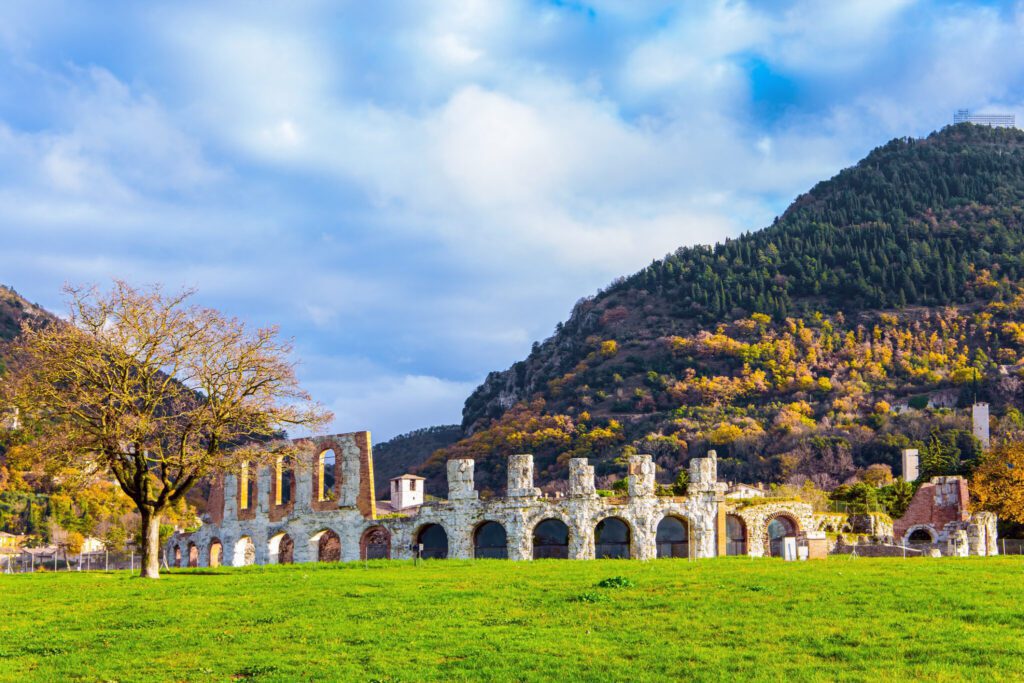
Le Marche
For serene landscapes off the path beaten into the ground by tourists, Le Marche provides the perfect opportunity to escape into familiar green hills, medieval towns, welcoming villages, splashing waves of the Adriatic Sea, and the pillared mountains of the Apennines. Hotel owners and home-renters have spent years trying to market the region as the new Tuscany or Umbria, when in fact Le Marche offers more than its better-known regional neighbors to the west.
A sliver of Lazio touches the southwestern corner of Le Marche. Abruzzo borders the region to the south with Emilia Romagna topping the region to the north. The region highlights its differences to Tuscany as opposed to its similarities. Homes in medieval villages shine with rich brown window shutters. The Adriatic shimmers with a clear, intense indigo, as opposed to the turquoise of the Tyrrhenian Sea. Even the pasta has different shapes than the rustic configurations of Le Marche’s famous neighbor, embodying one of the great differences amongst regional Italian cuisine. The slow rhythms of rural life enchant visitors between the Metauro River Valley and along the Adriatic coast.
The four provinces of Le Marche vary wildly. The northern province of Pesaro and Urbino touches the independent state of San Marino and overtakes the Metauro Valley. The southern province of Ancona retains unspoiled nature in the reserve of Monte Conero and Portonovo along the coast. Ancient civilizations inform the contemporary lives of residents in Ascoli Piceno and the historically well-endowed towns of Macerata provide lively ambiance across the hilltops drawing fans of opera, ballet, and sumptuous markets.
The mountains along the interior protect the temperate inland climate spreading from the northern continent, while the seaside keeps the temperature allied to a comfortable Mediterranean climate. Cold and snowy winters blanket the mountain slopes and summits. Rainfall averages nearly 60 inches a year along the plains and over 30 inches a year across the coastline. The entire region encompasses 3,616 square miles. Farmers grow cereals, vegetables, grapes, and cultivate animal products. They also hunt for truffles or produce olives.
Commercial fishing trades thrive near Ancona, San Benedetto del Tronto, Fano, and Cvitanova Marche. Church caves, white-pebbled cliffs, and the hometown of renowned Renaissance painter Raphael showcase a modicum of the region’s distinctive qualities impressing more and more visitors from around the world. Italians love to vacation along the beach towns of “Riviera del Conero,” which looks over the azure waters and silver sands of the east coast. Rich tradition, pristine scenery, and small intimate cities reflect the beauty of the unforgettable but rarely visited region.
Ancona
Ancona is a city emboldening visitors to look deeper than the surface, with beauty hidden deep beyond the grittiness of the port façade. Italians and visitors easily bypass seaside city whose population barely reached over 101,000 people in 2015, bound for more exotic areas of Europe on the overnight ferry to Croatia, Greece, or Turkey. The history of the city is as remarkable as the hidden depths of its beauty, connecting to Greek settlers from Syracuse, Sicily in the 4th century BC. The word Ancona derives from the Greek word meaning “elbow,” referring to the crux of the harbor east of town. Tyrian purple dye brought prominence to merchants in the city and Roman governance allowed the city to keep its own coinage along with the use of the Greek language. The city grew increasingly independent after the year 1,000 AD, eventually shifting to a powerful maritime republic with a fascinating oligarchy ruled by a committee of six Elders.
The contemporary port underlies the continued importance of the city as a strategic position for commercial, touristic, and naval goods. The 11th-century cathedral provides a grand view of the sea. The art gallery displays several masterpieces, including works of Titian. The archeological museum exhibits impressive bronze statues from Rome and epic artifacts from the original Greek settlers. The little-known part of Italy peels back its layers to reveal ancient and Renaissance grandeur, hilltop parks, and cozy cafes overlooking the golden seaside of Le Marche’s capital city.
Cingoli
The small town of Cingoli brings the dream of an Italian village to life. The romantic, quiet, fun, exciting, and family-oriented town is located less than 20 miles from Macerata offering a fantastic Workation destination In Italy to visit with family. Julius Caesar’s lieutenant Titus Labienus founded the ancient Roman settlement of Cingulum in 63 BCE at an elevated position of 2,130 feet above sea level. The fortified nature of the plateau made the town an important fixture in the civil wars leading to the Roman Empire. The town is also referred to as “The Balcony of Marche,” because of its coveted belvedere.
On a clear day, the viewpoint offers a panorama spanning the subtle hills, and vast plains leading to the Adriatic Sea and Croatian mountains on the eastern horizon. The best views are located behind the church of San Francesco. The main street of Corso Garibaldi connects to Piazza Vittorio Emanuele at the heart of what was once the Roman Forum. The designs built from stone look gold in the sunlight. The 16th-century town hall contains the newly arranged Museo Archeologico, which displays Bronze Age lumber.
The library houses the town’s art gallery, depicting images of serendipity and religious works, including Lorenzo Lotto’s splendid Madonna of the Rosary. Pope Pius VIII ordered a new façade for the baroque cathedral in 1829, but the work went unfinished after his premature death. Renaissance palaces line the street Via Foltrani, which once belonged to the noble families of the town. The side streets provide picturesque corners of the hidden village, emphasizing the beauty and charm of its position on the hill and the ways in which time has preserved the regional heritage and local traditions.
Urbino
Urbino is a spectacular hilltop town off the tourist trail in the region of Le Marche boasting Unesco World Heritage status for housing one of Italy’s greatest Renaissance palaces. Planning a trip to the small town on the hill can be tricky, as it stands out of the way of the major tourist destinations of Florence, Venice, and Rome.
Visitors interested in enjoying an authentic Italian experience by exploring the wealth of villages, towns, and culture outside Tuscany and Lazio should make the time to visit a quiet town that helped change the history of art. The history of Urbino began as a modest Roman settlement called Urbinum Mataurense, which means “the little city on the river Mataurus.”
During the Gothic Wars of the 6th century BC, Urbino grew in importance due to its strategic positioning. In the Middle Ages the feudal lords of the Montefeltro family sided with the Ghibellines during the tumultuous struggles between the Papacy and Holy Roman Empire, bringing about the most famous member of the regional rulers in the 15th century, Federico da Montefeltro.
The duke set the scene for the trendiest art scent in the century, gathering artists, architects, and scholars to create an inspirational brain trust inspiring the likes of the distinguished painter Raphael, who was born in Urbino. The small town is confined to a number of hilltops enclosed within defensive walls. Porta Valbona provides the entrance to the fabled city and Via Mazzini connects to the grand public square of Piazza della Repubblica.
The centuries following the great artistic and scientific awakenings of the city found the prominent town under the rule of the Papacy, French occupation, and eventually a reunified Italy by the early-1860s. Wild game dishes and sheets of egg pasta reflect the peasant tradition of local gastronomy. The art moved away from the frescoes and grew from the architecture in the form of earthenware by making tin-glazed pottery known as maiolica. The simple wares began in the 15th century and continue to decorate the homes, mansions, and museums of the town, along with engravings following the traditions of Mannerist principles.
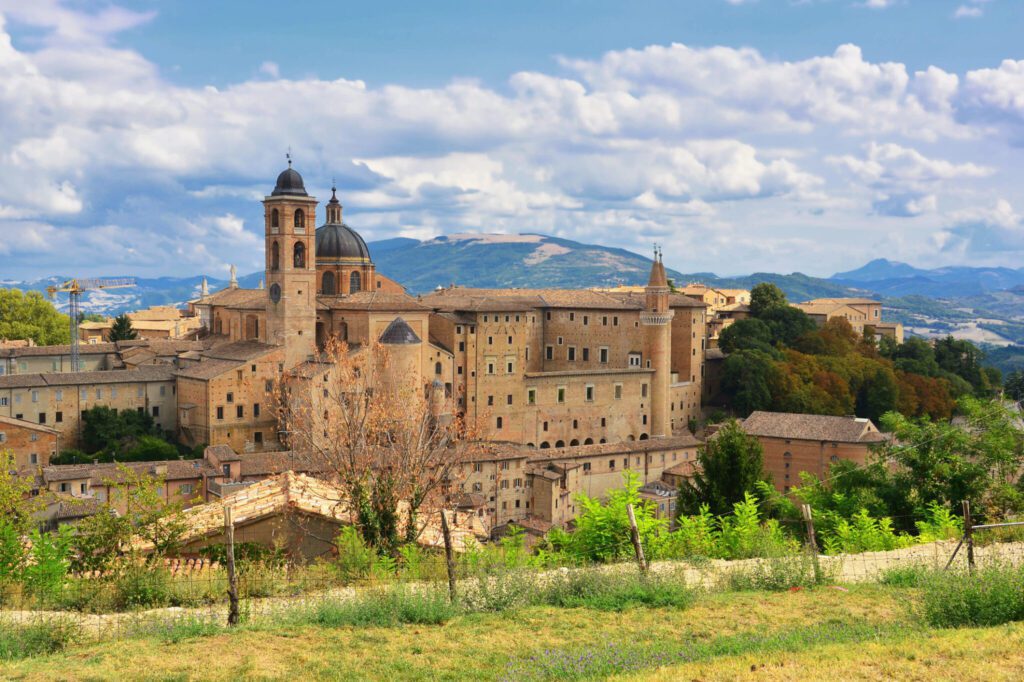
Lazio
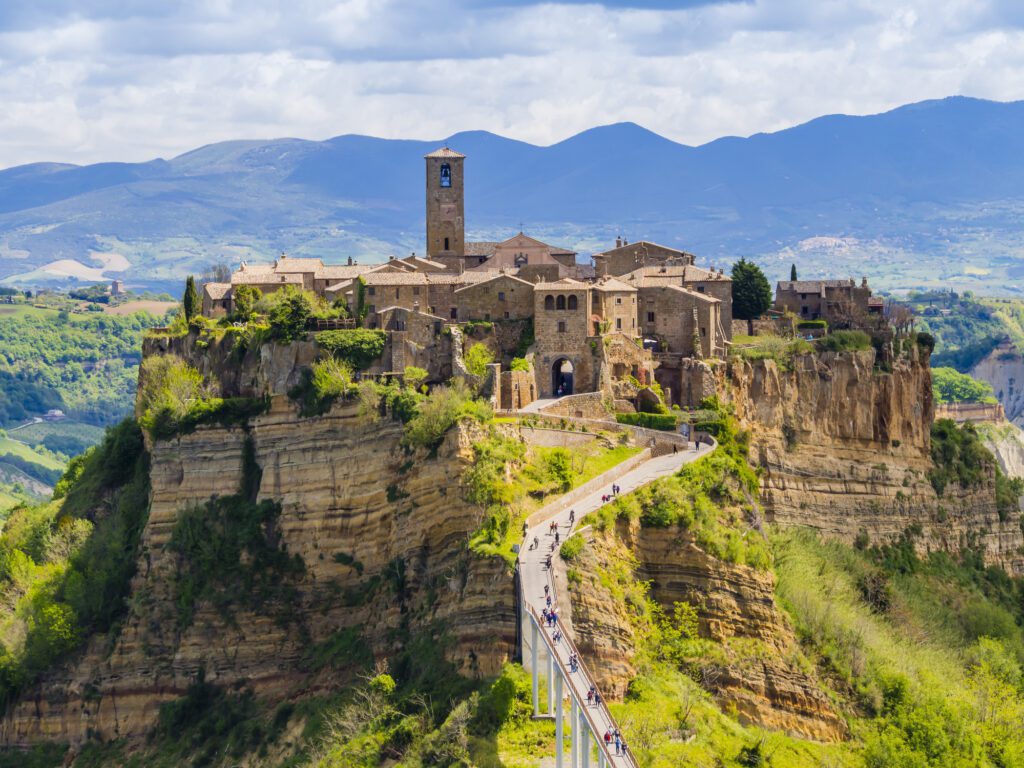
The region containing Italy’s capital Rome is surprisingly quiet outside of the tourism, construction, investments, and political ruckus concentrated in the metropolis. Crumbling medieval towns crown the hilltops. Faded palaces grace the golden grass and rolling dales. Tranquil lakes fill ancient volcanic craters and lead to thermal springs. Vineyards produce fine wines in connection to the former opulence of vast villas.
Tourists have populated the area since the Roman Empire with travelers visiting from around the globe eager to trade, learn, or view the glory of the country reaching nearly 1.7 million square miles. The Italian word “Lazio,” derives from the Latin Latium. Few residents of smaller cities continue to refer to the region by its Latin name.
Latini, meaning those who spoke the Latin language, made up the bulk of the multi-ethnic city of Rome during ancient times; the Etruscans are an example of other cultures populating the capital city and the region during the years of the empire’s global expansion. Roman mythology claims the early Latini took their name from the mythical king, Latinus. The Tiber River once acted as the northern border for the region, diving ancient Lazio from Etruria before Augustus officially united nearly the entirety of present-day Italy under a single geo-political banner. In the 18th and 19th centuries, travelers from around the globe returned to Lazio interested in exploring the grandeurs of the historic towns and religious capital of the Catholic world revived in imaginative style after the Renaissance.
The contours of the Tiber River no longer act as a framework to the region’s edges, and instead consist of topographical lines touching Tuscany, Umbria, and Le Marche to the north, Abruzzo and Molise to the east, and Campania to the south. The azure waters of the Tyrrhenian Sea create the western border. The region is mainly flat with waves of sporadic hills leading to small patches of mountainous areas in the east and southern districts. Sandy beaches lead to the headlands of Circeo and Gaeta, reaching nearly 1,774 feet and over 560 feet above sea level respectively. Other than the large draw for tourists, regional residents work in agriculture, crafts, animal husbandry, and fishery as their main sources of income. Farmers cultivate vegetables, fruits, olives, and grapes, with the latter production focused on wine.
The region has Italy’s second-largest economy after Lombardy. Archeological sites from the Roman Empire and Etruscan civilizations continue to interest scholars, historians, and cultural enthusiasts. The remains of the distant and distinctive cultures feature necropolises, temple complexes, imperial villas, and decorative grottos. Lazio cradles the evolution of Italian civilization, which intertwines with the development of Western Civilization, with a particularly strong connection to the expansion of the Christian religion and culture. Rome features great monuments and museums well known to travelers, accounting for an average of 10 million tourists a year..
The gastronomy retains ties to the original dishes of ancient Rome, preserving heritage in every bite and encouraging inspiration from the culinary past with new generations of intense chefs. History decorates the countryside, Vatican City, the smallest city-state in the world, continues to watch over Rome, and the ancient road of the Appian Way continues to lead to the capital city holding the country’s largest population contrasting the small, intimate villages of the region.
Rome
No matter how you prefer to travel in Italy, the capital of the country and the region of Lazio is the personification of historic opulence, faithful indulgence, and Italian tradition. For more than two millennia the roads around Western and Central Europe have led to Rome, inspiring pilgrims, calling to merchants, and intriguing tourists fascinated by the idea of the city’s seven hills along the banks of the Tiber River. The wealth of history dates back to before the Latini, with human settlement beginning approximately 14,000 years ago. You can peel back the dense layers of the past like an onion, discovering debris from Paleolithic and Neolithic civilizations through evidence of stone tools, pottery, and weapons.
A village topped Capitol Hill in the 14th century BC with continuing settlements growing over the original foundations ever since. The initial founding of the Eternal City remains a mystery, however mythology brings a fascinating tale to life through the story of the twins Romulus and Remus. A she-wolf suckled the orphaned babies who eventually founded the city, but not before Romulus killed his brother and lent his name to what would become an empire. The Roman poet Virgil reconciled conflicting legends in his 1st century epic The Aeneid.
The city captivates visitors with a sense of haunting ruins, inspiring vivacious street life, and a culture devoted to art, cuisine, tradition, and fun. Cafes line the streets and piazzas. Markets provide fresh fruit, vegetables, flower, and artisanal crafts. Tapestries, frescoes, statues, and archways decorate museums and parks, former palaces and antique restaurants.
Historical legacies burst from the street visible to pedestrian passersby en route to work or fascinated tourists snapping pictures on social media. Legendary artwork even decorates the churches, basilicas, and cathedrals spread throughout the city and moving beyond the works of Renaissance artists to feature medieval masterpieces and respected baroque treasures. Like the old adage says, “Rome wasn’t built in a day,” therefore, you shouldn’t think you can view it in a day. Try to stay clear of the most common pitfalls when visiting the classic and classical city.
Whether visiting as a family, an independent traveler, or on a passionate getaway trying to capture the amorousness from the classic romantic movie Roman Holiday, with Gregory Peck and Audrey Hepburn, it is easy to fall in love with Rome and stay far longer than you originally anticipated. With so many lavish and insightful ways to view Rome, here is a list of lesser-visited distinctive sites in and around Rome apart from the traditional crowd-pleasers of the Colosseum, Vatican City, Trevi Fountain, and Pantheon.
Tivoli
Tivoli provides the same sort of interest and opulence as reality shows that give insight into how the “other half” lives but instead of delivering a view to the lifestyles of Italy’s contemporary aristocracy, the town less than 20 miles northeast of Rome allows visitors to wander through the elegant and dramatic lifestyles of former popes, governors, and Roman emperors. The most famous attractions are the magnificent gardens of the Villa d’Este and the extensive ruins of Hadrian’s Villa.
The town is located along the banks of the Aniene River around the craggy hills of Monti Tiburtini. Rumors and legends of the town’s origins continue to add mystique to cobbled lanes and historic buildings. Gaius Julius Solinus cited the lost text Origines by Cato the Elder when claiming Catullus the Arcadian founded Tivoli after having escaped a slaughter of Thebes in Greece. Traces of settlement in the area date back much further than the claims of a Roman scholar, with archeologists unearthing artifacts from the 13th century BC. Two small temples above stunning waterfalls connect to the Sabine city during Etruscan reign, when Tivoli was the seat of the Tiburtine Sibyl. Romans used the area as a summer retreat to escape the heat and humidity of the capital.
During the Renaissance, popes and cardinals assembled powerful castles and vacation homes, including the massive Rocca Pia, which was a sign of aggression by Pope Pius II to control the population of what was once an independent commune between the 10th and 13th centuries.
The contemporary city has approximately 50,000 residents spread across the picturesque medieval center and homes scattered across the hills. With Roman temples and gorgeous villa complexes, powerful castles and stunning waterfalls, it is easy to fall in love with the view of how the rich and powerful lived through the ages.
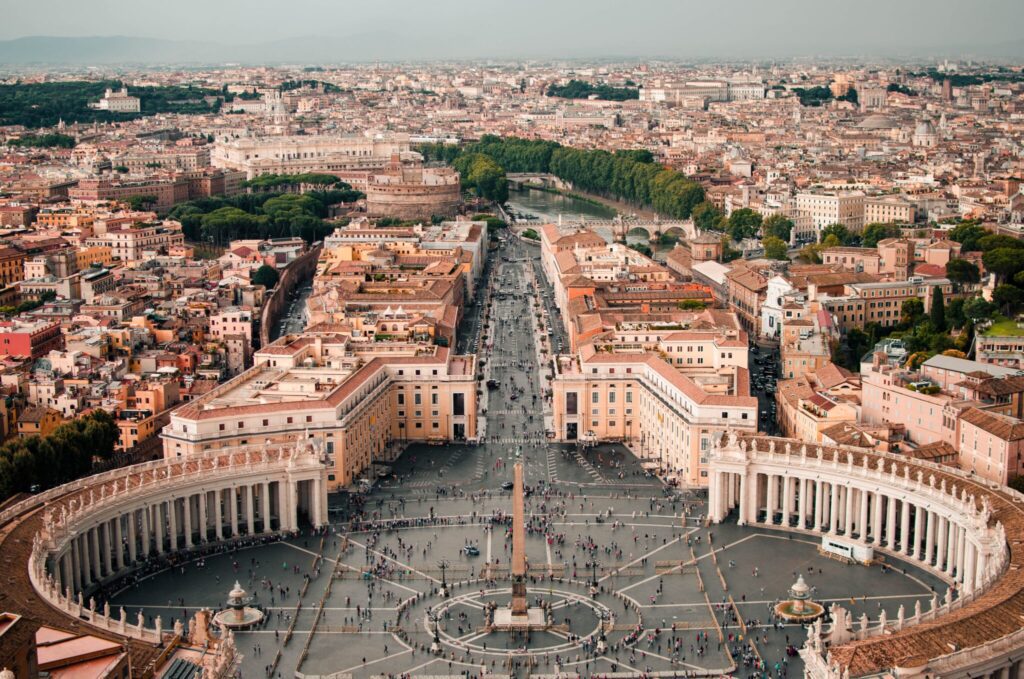
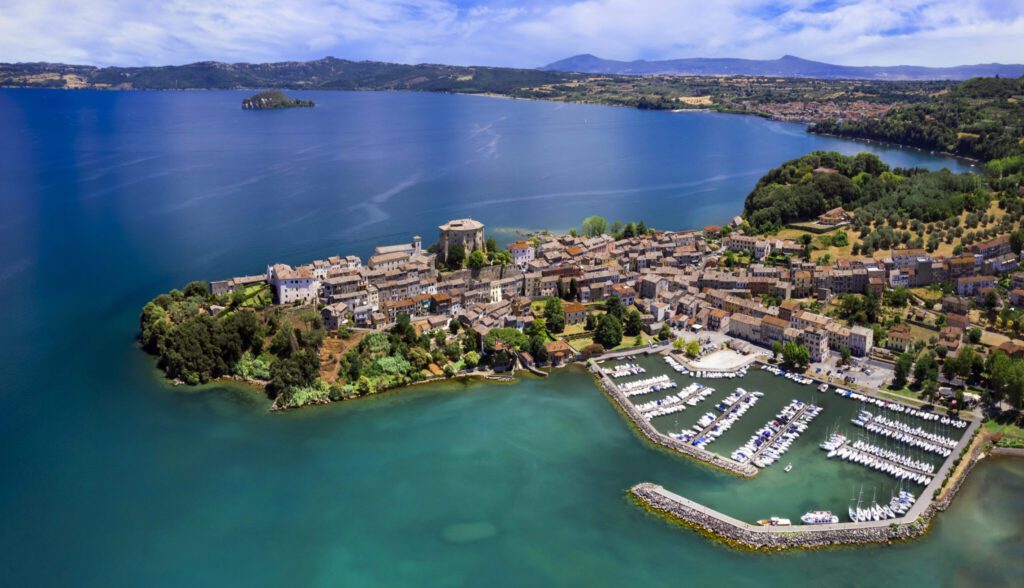
Viterbo
The largest town of northern Lazio is located approximately 50 miles north of Rome, surrounded by the rising slopes and summits of Monti Cimini and Monti Volsini, which reach nearly 3,500 feet and over 2,100 feet above sea level respectively. The medieval walls continue to protect the town, one from invaders, and now from the tourist hoards. Archeological finds have unearthed ancient humble origins predating the Etruscan settlements. The pre-Roman peoples used Viterbo as the center of the Etruscan civilization leaving remains from as early as the 8th century BC decorating the surroundings.
The Lombard King Desiderius commissioned greater walls to defend the capital against retribution from Rome after his vain attempt to conquer the city to the south in 773 AD. Popes found special favor in Viterbo during their tumultuous time controlling Rome and nearby cities in the Middle Ages, growing the town’s power and prestige before the papacy returned to their stronghold in Rome, placing Viterbo as a place of secondary importance.
Coats of arms continue to decorate the architecture depicting the lion and the palm tree. The lion represents Hercules, who, according to legend, founded the city millennia ago. The palm tree represents the power of the Viterbo during the Middle Ages when the local government annexed the neighboring town of Ferento.
The Latin letters FAUL surround the images but the meaning of the letters has been lost to time. The medieval architecture continues to intrigue visitors from around the world highlighting the preserved papal palace, humble lanes, and a collection of intimate churches.
The authentic atmosphere has also brought film crews eager to shoot period pieces around the medieval alleys of San Pellegrino and the unaltered stone houses with external staircases. The city also boasts a popular antiques trade with a renowned fair taking place on the third Sunday of every month.
Bagnoregio
Few places in Italy can take you so far off the beaten path even Italians don’t live in the area anymore. The town of Bagnoregio, located in northern Lazio 75 miles outside of Rome, is one of the most dramatic features tourists don’t know about. Residents of Lazio and the few remaining in Civita di Bagnoregio call the town il paese che muore, “the dying town.” A footbridge acts as the only access to the summit of the crumbling tufa rock at over 1,000 feet above the deep ravine and 300 feet above sea level.
Etruscans founded the village more than 2,500 years ago. Saint Bonaventure was born in Bagnoregio and died in the year 1274. His boyhood home has since fallen off the edge of the receding cliff in a town in decline since the 16th century and eclipsed by its safer suburb. Earthquakes and erosion have caused mass exoduses since the 17th century when the bishop and municipal government moved away from the historic city center. The bridge once supported by clay and soil became a hanging bridge tethering the remains of the town on the plateau to the surrounding hills.
The population of Bagnoregio varies between seasons, falling to as much as 12 people in the winter and 100 people in the summer. The World Monuments Fund listed the town as one of the world’s 100 Most Endangered Sites in 2006 due to the threats of erosion and, at the time, unregulated tourism.
The former threat remains. Medieval walls once protected the town now surrounded on three sides by steep cliffs plunging into the ravine. Rather than a specific work of art or a selection of historic structures to visit, Bagnoregio is in and of itself a feature worth seeing. Statues adorn the entrance gate of Porta del Cassero. Lions hold human heads, embodying the power of the church.
The cathedral stil stands and hosts the religious heritage of the city from the structure’s inception as early as the 7th century AD until 1699 when the religious leaders fled from the crumbling town. The buildings and streets retain their medieval design with little changed over the half millennium. Tiny pick-up trucks travel on the bridge carrying supplies, offering unique solutions to the problems the town faces after the eroding soil finally tore away the donkey path. The Roman Arch, a façade of a Renaissance palace, and the public piazza present the remaining luster of the unique townscape. Careful of the long bridge. It looks easy but gets very steep the closer it leads to the heart of town.

Book Your Central Italy Workation
The central regions are often considered the epitome of what travelers expect during an Italy trip. With rolling hills and delicious food, winding rivers and exceptional museums, Central Italy is a place to explore ruins and experience cafe culture, tour villas or enjoy a food tour.
There are many differences between Italy’s North, Central, and South and you can find more ideas on where to go across the country for your Workation with our breakdown on the different areas of the Northern Italy Region and Where to Visit and the Southern Italy Region and Where to Visit.

